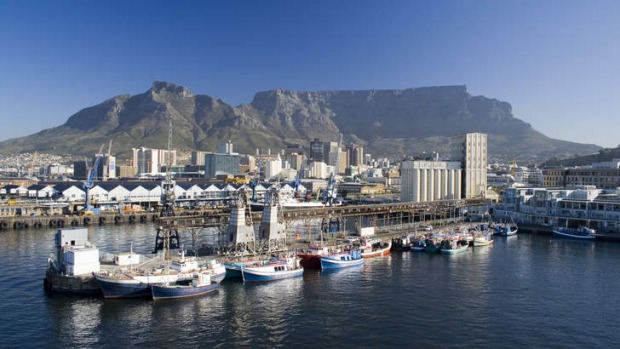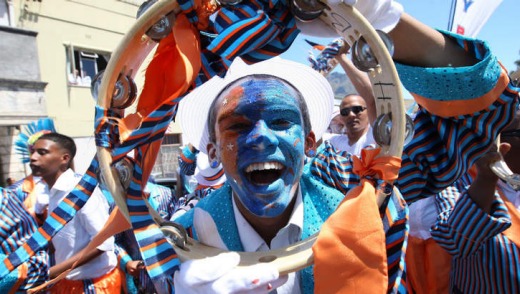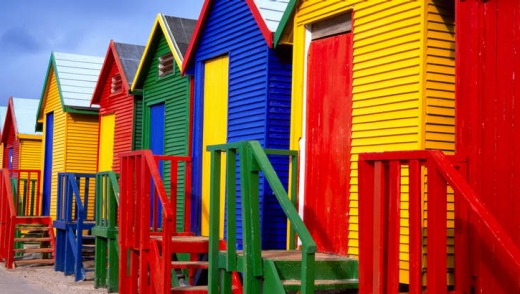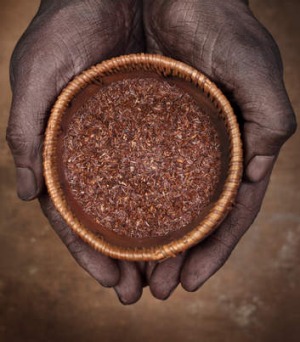
1 IT'S THE WORLD DESIGN CAPITAL FOR 2014
On January 1, Cape Town takes over from Helsinki as World Design Capital for 2014. This project, established in 1957, celebrates cities that have used design to reinvent themselves, as Cape Town has since the end of apartheid. So there's never been a better time to visit, with more than 450 innovative, interactive, sustainable and community projects and events. See wdccapetown2014.com.
2 TABLE MOUNTAIN

Take the cableway to the top of Cape Town's most recognisable landmark, one of the New7 Wonders of Nature. The revolving floor in each cable car ensures a 360-degree view on the way up to the top, 1085 metres above Table Bay. The views are amazing - of the city, the coastline, abseilers dangling from rock faces, hikers and mountain bikers. You may see a dassie, a native guinea pig related to the African elephant - really! Tickets half-price after 6pm in summer. See tablemountain.net.
3 ROOIBOS (RED BUSH) TEA
There's no better place than Cape Town to drink South Africa's trademark tea, known for its health benefits. For 10 times the antioxidants as regular rooibos tea, try a caffeine-free "red espresso" at Mugg & Bean, which serves red cappuccinos and red lattes. Or drink it cold: Bos organic iced rooibos tea in a can comes in several flavours. See redespresso.com; bosicedtea.com.

4 VICTORIA & ALFRED WATERFRONT
Named after Queen Victoria's son, Prince Alfred, who tipped the first rocks into Table Bay to begin construction of Cape Town's harbour in 1860, this historic waterfront redeveloped in the 1990s is now South Africa's most visited destination - more than 400 shops, 80 cafes and restaurants, and numerous bay-view hotels. Attractions include Robben Island Museum, the Two Oceans Aquarium and Nobel Square, where you can take a "selfie" with bronze statues of Nobel Peace Prize laureates Desmond Tutu, former presidents Nelson Mandela and F.W. de Klerk, and anti-apartheid campaigner Nkosi Albert Luthuli. See waterfront.co.za.
5 ROBBEN ISLAND

This small prison island 7.5 kilometres from the V&A Waterfront was Ground Zero for the end of apartheid in 1994. World Heritage listed in 1999, it's best known as the place Nelson Mandela spent 18 years of his life. You can see his tiny concrete cell on a three-hour tour of the island led by other former political prisoners. Tours start and end with a half-hour cruise across Table Bay watching seabirds, whales and dolphins. See robbenisland.org.za.
6 THE CAPE PENINSULA
You don't have to go all the way to the Garden Route, which starts 400 kilometres east of Cape Town, for coastal scenery. Just south of the city is one of the world's most spectacular day-drives, down the Cape Peninsula to Cape Point and the Cape of Good Hope (which isn't the southernmost point in Africa; that's Cape Agulhas, 150 kilometres to the east). Pretty hamlets, wild beaches, rocky coves and lonely lighthouses are just the beginning; the highlight is the 9-kilometre Chapmans Peak toll road, which twists and turns over a mountain pass from one side of the peninsula to the other. See chapmanspeakdrive.co.za.
7 DISTRICT SIX
In 1966, a vibrant and multicultural part of Cape Town was torn apart when the apartheid regime turned it into a whites-only area and bulldozed the homes of 60,000 people who were relocated to the barren Cape Flats area outside the city. Now most of District Six is grassy, vacant blocks of land. The District Six Museum, which opened in 1994, tells the stories of those who lived there, many of whom want the area to remain undeveloped in remembrance. See districtsix.co.za
8 CAPE TOWN MINSTREL CARNIVAL
More than half of Cape Town's 3.1 million residents are Cape Malay, so-called because their ancestors, who arrived as slaves from others parts of Africa and India or were exiles from the Dutch East Indies, spoke the most common trading language of the time, Malay. On January 2 every year, more than 10,000 Cape Malays celebrate their heritage in a colourful, African-American-inspired street parade of satin, sass and sequins known in Afrikaans as Kaapse Klopse. See capetown-minstrels.co.za.
9 SHORE-BASED WHALE-WATCHING
South Africa claims to have the world's best shore-based whale-watching. One of the best places to watch migrating humpbacks, southern right whales and Bryde's whales between June and October every year is Hermanus, 90 minutes from Cape Town on the south coast. This little town gets busy in whale season: it's South Africa's whale-watching capital, has the world's only "whale crier" and hosts an annual whale festival in September. See hermanus.co.za; whalefestival.co.za.
10 THE GRAND DADDY
Long Street in downtown Cape Town is the Soho of South Africa, with lively clubs, cafes and restaurants. It's also home to the city's most unusual hotel. In addition to more "normal" rooms The Grand Daddy, at 38 Long Street, has an Airstream Rooftop Trailer Park, featuring the great design classic aluminium Airstream caravans with interiors designed by local artists; the seven "always-surprising capsules of glee" range from tributes to John and Yoko to "Goldilocks and the 3 Bears". There's also a rooftop cinema, the Pink Flamingo.
See granddaddy.co.za.
11 BEAUTIFUL BEACHES
South Africa has beaches to rival the best in Australia, even in Cape Town. For instance: posh Camps Bay and Clifton (the Bondi and Tamarama of Cape Town); Boulders Beach, where you can see South African penguins; Blouberg Beach for Table Mountain views as you swim; Llandudno on the Cape Peninsula for surfing; and family-friendly Fish Hoek. Be warned, however, water temperatures tend to be on the icy side, even in summer.
12 THE BLUE TRAIN
This legendary luxury hotel on rails takes you on a 27-hour journey across South Africa from Cape Town to Pretoria, a distance of 1600 kilometres. The dream begins with welcome cocktails, after which your butler will show you to your suite. Then there's brunch, lunch, high tea, a 45-minute stop in historic Matjiesfontein (the entire village was declared a national; heritage site in 1975), dressing for dinner, perhaps a glass of cognac and a Cuban cigar before bed. Rates start at 13265 rand (about $1400) per person.
See bluetrain.co.za.
13 LION'S HEAD
On summer evenings, do as Capetonians do and pack a picnic, hike up to Lion's Head (which takes about an hour) and sit on this peak's grassy flanks with a glass of local wine in hand, looking down on the city and watching the sun set into the Atlantic from 669 metres above sea level. Go during a full moon and you'll see the moon rise as well.
14 WOODSTOCK
There's no music at this Woodstock, just hipsters. The Old Biscuit Mill is its epicentre, with shops selling anything that can be hand-crafted, the Neighbourgoods Market (every Saturday 9am-2pm, for farm-fresh produce and gourmet food trucks) and two restaurants by British uber-chef Luke Dale-Roberts, The Test Kitchen and the Pot Luck Club. There's even locally made beer, at the Old Castle Brewery. See ilovewoodstock.co.za; neighbourgoodsmarket.co.za.
15 WINE COUNTRY
Cape Town's cellar door is Constantia Valley, South Africa's oldest wine-growing region, but you're spoilt for choice in this Western Cape region. There's the world's longest wine route, which stretches 850 kilometres from Cape Town to Port Elizabeth; the world's first Fairtrade-certified winery, Thandi; and Stellenbosch's 200-plus wine makers and grape growers. You can even take a wine tour on horseback. See constantiavalley.com; thandiwines.com; wineroute.co.za; paradisestables.co.za.
16 DIAMONDS AND GOLD
These two precious things put South Africa on the map. Cape Town Diamond Museum, at the V&A Waterfront, has half-hour tours covering everything sparkling.
At Jewel Africa, you can design your own diamond jewellery and have it made within 24 hours. While you're waiting, do a torchlit night tour of the Gold of Africa Barbier-Muller Museum, which begins with a glass of wine sprinkled with gold leaf. See capetowndiamondmuseum.org; jewelafrica.com; goldofafrica.com.
17 BUILT HISTORY
Download Cape Town Tourism's "Walking Tour of Cape Town" app, hit the streets and you'll get a sense of the city's chequered past, written in bricks and mortar. The Castle of Good Hope, complete with moat, is the city's oldest structure (built 1666-1679) but the city is a mash-up of architectural styles, from the neo-classical City Hall and Art Nouveau structures not unlike New York's Empire State Building to candy-coloured Georgian row-houses in Cape Malay Bo-Kaap. See capetown.travel.
18 THE BIRKENHEAD DRILL
The words "women and children first" were first uttered off the coast of South Africa, east of Cape Town, in the early hours of February 26, 1852, when a Royal Navy frigate, HMS Birkenhead, struck uncharted rocks and sank, two kilometres off Danger Point. The captain's order subsequently became a maritime code and the Danger Point lighthouse, built in 1895, has a plaque dedicated to the 440 men who lost their lives on the Birkenhead.
19 SOUTH AFRICAN JEWISH MUSEUM
This stylish museum, with its entrance in the city's first synagogue (built in 1863), was opened in 2000 by Nelson Mandela, whom the chief rabbi of South Africa called, "The role model of what a human being could be"; the museum screens a documentary about Mandela but focuses on the journey of South Africa's Jews, from the first immigrants who fled persecution in Eastern Europe in the 1880s. See sajewishmuseum.co.za.
20 NATIVE FLOWERS
One of the grandest botanic gardens in the world, and the first one dedicated to a country's native flora, the 36-hectare Kirstenbosch National Botanical Garden is part of a 528-hectare estate on the eastern slopes of Table Mountain, and part of the World Heritage-listed Cape Floristic Region. There are walking tracks through the fynbos (native vegetation that includes the king protea, South Africa's national flower) and Afromontane (African mountain) forest. There are also Sunday afternoon concerts in summer.
See sanbi.org.